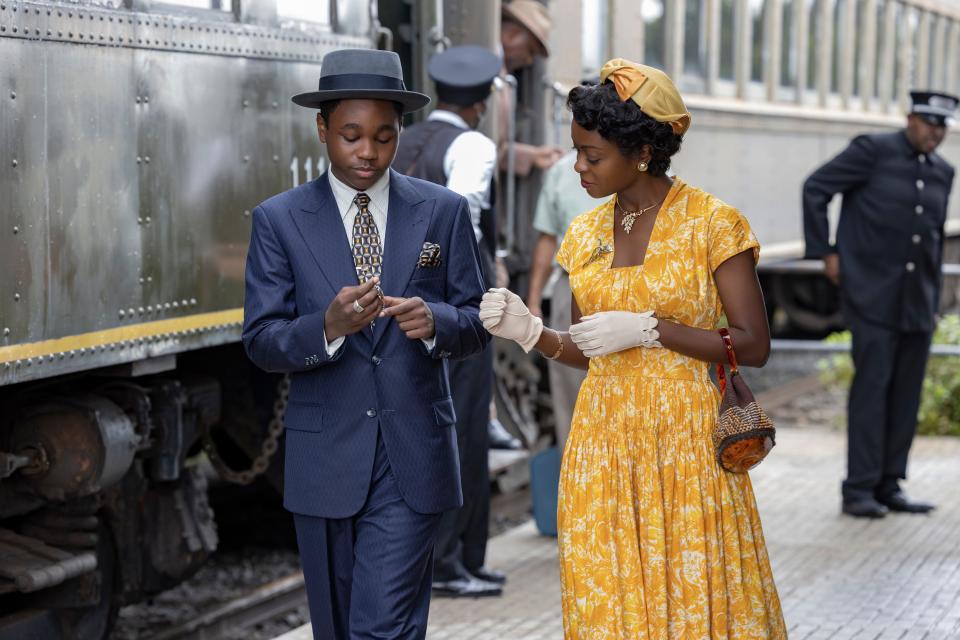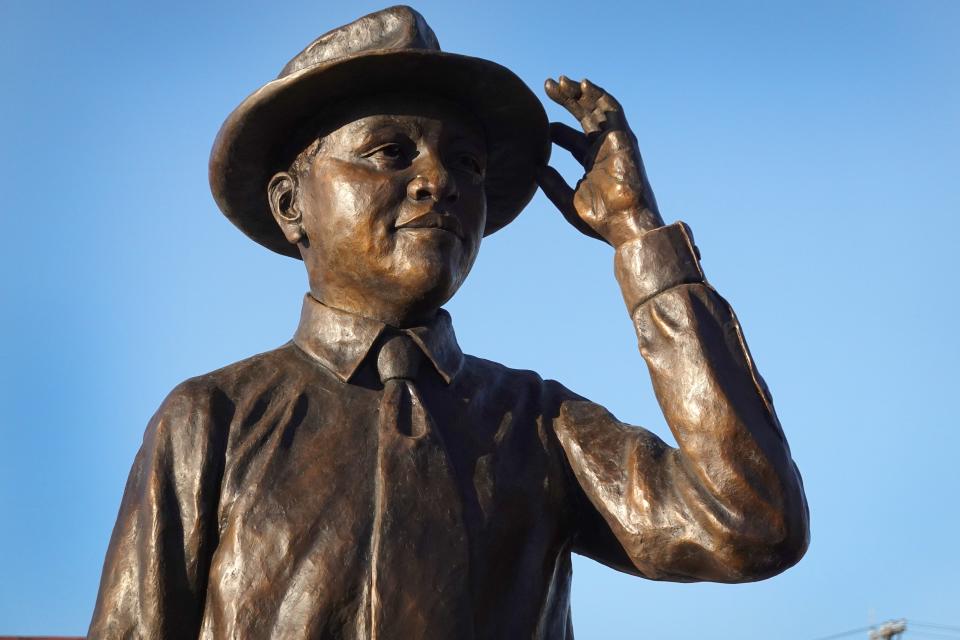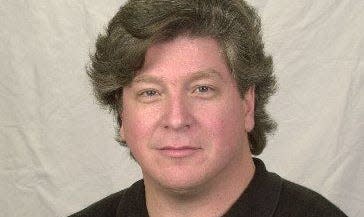Facing the stark truth of 'Till' | MARK HUGHES COBB
- Oops!Something went wrong.Please try again later.
Go see "Till." Danielle Deadwyler, playing Mamie, should be awarded all the Oscars. Her visceral portrayal rolls in incessant, tidal-powered waves over stunningly long stretches, in unbroken takes, underlining that this grief, this tragedy, was damned real. Insane. Horrific.
Hours after the movie, I found myself worrying for the actor's health. How she carried that off, how she absorbed Mamie Till Mobley's ordeal so thoroughly, projected it so powerfully, I can't know. And I've seen, known and witnessed amazing actors.
One word: magnificent.
Director Chinonye Chukwu notes it was crucial that they only shot some takes once or twice, taking breaks often. Jayln Hall, fhe 14-year-old actor playing Bobo − family nickname for Emmett − needed breathers from filming the abduction scene, to get hugs from his mother.
About 12 years ago, Billy Field wrote a play about another person who added to the story, Hartselle, Alabama-born and University of Alabama-educated writer William Bradford Huie, who wrote an article on the murder for Look magazine, one that − with photos approved by Mamie, showing raw, gruesome images from Bobo's open casket − helped light the fuse for the burgeoning civil rights movement.

Huie was important: His prestige as a journalist and novelist (several of his books were made into movies, such as "The Americanization of Emily," "Wild River," "The Revolt of Mamie Stover," "The Klansman," and "The Execution of Private Slovik") helped get the Look story published. He co-edited one of the first hourlong TV news shows, "Longines Chronoscope," produced in New York City, interviewing John F. Kennedy, Joseph McCarthy and Clare Booth Luce, along with other politicians, scientists and economists. Young William F. Buckley worked for Huie, when he was editing literary magazine The American Mercury, a journal founded by H.L. Mencken and George Jean Nathan.
Huie was bold, brash. He went undercover, infiltrating the mob to report on Benjamin "Bugsy" Siegel. He served as a war correspondent in the Pacific theater, writing about the flag-raising at Iwo Jima, honing in on the tale of Ira Hayes, adapted into 1961 movie "The Outsider," starring Tony Curtis.
Contacted by Zora Neale Hurston, Huie drove to Florida to cover the 1954 trial of wealthy married Black woman Ruby McCollum, who shot and killed her lover, a physician and state senator being groomed to run for governor. McCollum stated under oath he had forced her into sex, and made her bear his child. Huie dug in, even though the judge tried to clamp down, preventing McCollum from talking. The judge cited Huie for meddling, and had him arrested on contempt of court. Freed from jail, and pardoned years later, Huie wrote the 1956 bestseller "Ruby McCollum: Woman in the Suwanne Jail." It was banned in Florida, but Ebony, Time and others published Huie's work worldwide.
Familiar with the Deep South, Huie reported extensively on racial matters including the 1964 killing of Freedom Summer registration workers James Chaney, Andrew Goodman and Michael Schwerner, in "Three Lives for Mississippi." The Rev. Martin Luther King Jr., wrote the introduction for that book's second edition. Huie later interviewed King's assassin James Earl Ray, for "He Slew the Dreamer."
Heck, Huie was wild enough to write an article for Collier's on how his alma mater was paying football players ... back in 1941.
Huie was controversial: In 1955, he drove to Mississippi and paid two of Bobo's murderers − acquitted by an all-male, all-white jury − $4,000 cash (worth more than 10 times that now) to talk. After the Look story, he wrote a full-length book about the travesty, "Wolf Whistle," published in 1959.
Billy created a show-within-a-show, in which I was privileged to play Huie − or a Huie-spirit inhabiting the body of a UA prof; or possibly just a crazy person, but one with intimate knowledge of Huie's life − for a sold-out Bama Theatre crowd in November 2010, including his widow (Martha Hunt Robertson, who Huie married after wife Ruth died from cancer) and old pal and fellow journalism legend Wayne Greenhaw, who also wrote extensively about the KKK, and helped break the horrors of American troops committing atrocities in Vietnam, the My Lai massacre.
(Wayne wrote afterward: "Mark: I truly enjoyed your performance Wednesday night in 'William Bradford (Who He?) Huie: Voice of the Voiceless' in which you did a great job portraying my old friend and teacher, Bill Huie. You got his swagger and his essence down pat. As you spoke, I could hear him. As you stood there with your feet apart and your hands on hips, I could see him. And after the play, I enjoyed very much sitting and talking with you. Good luck to you in all of your endeavors." I wrote back, thanking him profusely, hoping we could meet again. Wayne died May 31, 2011, before I could make a reunion happen. Don't hesitate, folks. Never wait.)
The climax struggled with Huie's legacy: "checkbook journalism." Why is that so awful? Because, like confession under torture, you're fed poisoned fruit by a person highly motivated to say what you want to hear.
Aside from celebrating Huie, that was the story's core: "Truth." What does that mean? What is its power? How do we wield it? How do we grasp it, when the reality is every story has 7.9 billion sides, not two?
Near the end, everyone's on stage, as Huie is arguing with someone, purportedly a journalism student (planted). His/my line went something like "We weren't going to get justice! .... But maybe we could get some truth."

That was what it was all building toward, but I didn't know what to do with those lines other than just speak straight out, because that's often the most effective thing: Trust the words; trust the story.
But at dress rehearsal, I stopped glaring at the plant, and looked over to the actress playing Mamie, a beautiful young UA student, one blessed with the grace and style that often saw her cast older.
And she was ... magnificent. I think Billy, and I, and Sara-Margaret, and Wes, and Joel, and all the other white creatives working on this project were fully invested. We believed. We wanted to tell this harrowing tale, work toward truth. But when I looked in her welling eyes it just. … I got it, much as any white man can, from that woman channeling suffering hero Mamie. There are so many ways in which even empathetic, progressive, well-meaning people can never understand others' pain. But she radiated, just as the "Till" movie's Deadwyler has done.
When I looked over, during words hammering home the failure of justice, then the possibility of truth, that's when a good show elevated. This original play about a guy most of the 800 or so watching had never even heard of before drew a spontaneous standing ovation, and I'm sure that her work, that moment, is absolutely why.
Without saying a word; with fury, frustration, the hope that attention would be paid glowing from within her: I think everyone got swept up in cascading waves of injustice, crashing up against the jagged rocks of semi-reliable truth.
Photos of Bobo − as a joyous 14-year-old boy, and after murderous devastation, an image of horror − were projected on the stage's back wall. I turned around and looked up once, to see if directing my/Huie's gaze that way would add something. I only did it once, because I lost all my words. It was, for as unreal as all art is, visceral. Real.
We could have done a silent production, just based on photos and that young woman's eyes, and everyone would have gotten it, from the truth of those looks.
"Till" is unflinching, as Mamie was, insisting the warped, decomposing body of her murdered only child − left to bloat in a river for days, after being hideously tortured, beaten, shot − be put on full public display. Be photographed. Be witnessed, for what it told about the lack of justice, about the nightmare of truth.
It'll hurt to see "Till." You may vibrate with outrage, dehydrate weeping.
But if Mamie Till could look straight at that truth? So should we all.

Reach Tusk Editor Mark Hughes Cobb at mark.cobb@tuscaloosanews.com, or call 205-722-0201.
This article originally appeared on The Tuscaloosa News: Facing the stark truth of 'Till' | MARK HUGHES COBB

